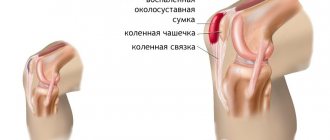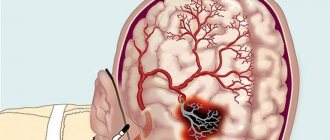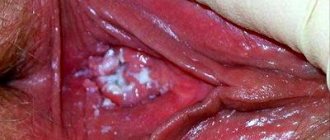A very large number of women have encountered such a problem as uterine bleeding. These are mainly women of reproductive age. These can be both young teenage girls and women during menopause. Sometimes uterine bleeding is difficult to recognize, especially if it occurs during menstruation. An alarm bell is that the discharge is more abundant, the bleeding itself did not occur according to the cycle schedule. It can also be longer, which should also attract attention.
Briefly about the physiology of the menstrual cycle
For a simplified understanding of this complex system, the regulation of the cycle can be compared to a five-story building, where each lower floor is subordinate to the one above, but it is quite obvious that the upper floor cannot function independently without its “subordinates.” This comparison reflects the main principle: the existence of direct and feedback connections between all levels of regulation.
It is she who is the main executive body and is influenced by all higher levels. It now becomes clear that uterine bleeding is a symptom that can appear when there is a disturbance at any level. This means that effective treatment should be carried out not only with hemostatic drugs, which essentially represents a fight against the investigation. The most important thing is to find the reason.
So, on the first “floor of the building” the uterus is located.- We rise higher to the “second floor”: the ovaries are located here. They are an endocrine gland and produce a large number of hormones: estrogens, progesterone, androgens. Estrogens predominate in the first phase of the cycle, and progesterone predominates in the second. However, the ovaries are also not autonomous and are subject to higher levels of regulation.
- The pituitary gland is located on the “third floor” which produces:
- follicle-stimulating hormone (FSH) – is responsible for the processes of maturation of the dominant follicle in the ovaries;
- luteinizing hormone (LH) - its peak causes ovulation (the release of an egg) in the ovaries.
- The “fourth floor” is occupied by the hypothalamus. The so-called “liberins” stimulate the pituitary gland, and “statins”, on the contrary, suppress the production of hormones. In addition, for the normal functioning of the reproductive system, the cyclical flow of hormones into the blood is important. Numerous studies prove that normally, hypothalamic hormones enter the bloodstream every hour.
- And finally, the “fifth floor” is rightfully occupied by the cerebral cortex, that is, the central nervous system. This means that any stress, difficult situations that happen to us, all affect the regulation of the menstrual cycle. This explains the cause of bleeding in women under stress.
Classification of uterine bleeding
Depending on the age factor:
- Juvenile – occurs in teenage girls from the age of menarche (first menstruation) to 18 years.
- Reproductive age – typical for women over 18 years of age and before menopause.
- Menopausal – occurs in women who are in the menopausal period.
In relation to pregnancy:
- Uterine bleeding during pregnancy:
- in the first trimester (up to 12 weeks);
- in the second trimester (from 13 to 26 weeks);
- in the third trimester (from 27 to 40 weeks).
- Postpartum hemorrhage:
- in the early postpartum period (within 2 hours after birth);
- in the late postpartum period (within 42 days after birth).
Juvenile bleeding is a consequence of disruption of the hormonal regulation of the menstrual cycle in girls. The main problem is that girls rarely turn to a gynecologist with this problem for many reasons:
- They are embarrassed to tell their parents about cycle disorders;
- People mistakenly think that menstruation will become regular after some time. However, many studies have been conducted on the basis of which we can conclude: in the absence of treatment for cycle disorders during puberty, persistent abnormal changes in the menstrual and, most importantly, in the reproductive function of the female body subsequently develop.
- Girls confuse menstruation with uterine bleeding.
When it becomes necessary to stop the regulator
Before looking for methods that will help stop discharge that has already begun, you should know the reason why the regulation has been delayed for a long period.
If a woman wants her period to stop earlier by one day or even a few hours, for example, in order to go on a date or go on vacation without additional discomfort, she must find out whether her health condition allows such initiative.
There are a number of physiological and pathological reasons that can cause an increase in the duration of regulation. If a woman’s menstruation is delayed due to the fault of one of them, there may be a need for medication to stop the heavy discharge. Stopping menstruation may be indicated in the following cases:
- hormonal imbalance caused by progesterone deficiency;
- improper functioning of the endocrine system, which was provoked by a lack of balanced nutrition, alcohol abuse, coffee and nicotine addiction;
- diseases of the genital area. In this case, severe bleeding may be caused by cysts and other neoplasms;
- stressful situations and psycho-emotional instability;
- overweight or underweight;
- consequences of previous surgical interventions;
- menopause.
There are many methods that can be used to stop menstruation, but you should not resort to them just to go to a party or relax a little longer at sea. Artificial stopping of regulation is justified only if it helps alleviate the woman’s condition or improves her health.
How to distinguish normal menstruation from bleeding during the menstrual period?
Criteria for normal menstruation:
- The duration of the menstrual period does not exceed 7 days;
- The volume of blood lost does not exceed 80 ml;
- Menstrual blood should not contain large blood clots.
At first glance, these are quite simple and clear criteria, but it is not always possible to calculate blood loss in milliliters. In addition, the system for assessing blood loss using the visual method is very subjective and is fraught with many errors. Even experienced doctors cannot always determine the amount of blood loss by eye, so for young girls this is very difficult.
For this reason, according to statistics, about 20% of uterine bleeding is mistaken for menstruation, which means that every fifth girl from this risk group is exposed to long-term chronic blood loss (anemia).
In this regard, a completely fair question arises: what other signs can be used to distinguish pathological blood loss from physiological?
Typically, such girls have characteristic symptoms:
- Pale skin;
- Brittle, dry hair;
- Dull nails;
- Expressed weakness, fatigue;
- Reduced performance;
- Possible fainting;
- Cardiopalmus.
Video: dysfunctional uterine bleeding, program “Live Healthy!”
Kinds
The main types of bleeding include:
- dysfunctional;
- juvenile;
- breakthrough;
- profuse.
The main signs of dysfunctional bleeding are considered to be large blood loss and/or too long periods. The risk group mainly includes adolescents and women during menopause. The provoking factor is considered to be an excessive amount of sex hormones. To eliminate this pathology, hormonal therapy is required.
This type of bleeding is divided into ovulatory and anovulatory. The first is characterized by the manifestation of an abnormal cycle. This means that there is a small discharge or short periods, more than one month apart. Anovulatory symptoms are characterized by cycle disruption, significant blood loss, loss of appetite, poor health and drowsiness.
Juvenile bleeding may occur seasonally. This can be explained by the fact that the corpus luteum is not formed due to hormonal imbalance. Breakthrough bleeding occurs as a result of problems with the uterus, which can be caused by an intrauterine device. In addition, they can be caused by taking hormonal contraceptives.
Profuse blood loss is quite difficult to distinguish from normal menstruation, since they are not characterized by the presence of pain. The only sign may be a severe loss of fluid mobile connective tissue with scarlet discharge.
Causes and treatment of uterine bleeding in girls
The main reason for such menstrual cycle disorders is changes in hormonal status, namely:
- Violation of the production of the hormone progesterone by the ovaries;
- A change in the ratio of pituitary hormones (an increase in follicle-stimulating hormone (FSH) and a decrease in luteinizing hormone (LH). Insufficient LH levels also lead to the fact that ovulation does not occur;
- Excessive estrogen content in the body;
- Pathology of the thyroid gland, adrenal glands.
Important! For the full functioning of the female reproductive system, it is important not only the quantitative content of hormones (their concentration in the blood), but also the ratio of one to the other. In other words, if, according to the results of the study, the concentration of sex hormones falls within the physiological norm, then this does not yet indicate complete well-being. It is for this reason that only a doctor can correctly evaluate the results of laboratory tests.
In addition, the causes of uterine bleeding are also:
- Disorders of the blood coagulation system (thrombocytopathies, von Willebrand disease, hemorrhagic vasculitis, thrombocytopenic purpura);
- Various anomalies of uterine development;
- Adenomyosis is manifested by prolonged menstrual bleeding, which is accompanied by severe pain in the lower abdomen;
- Oncological blood diseases (leukemia);
- Ovarian cysts;
- Pituitary tumors;
- Inflammatory diseases of the female genital organs sometimes lead to uterine bleeding;
- Increased endometrial thickness or polyp in the uterine cavity.
Treatment methods for juvenile uterine bleeding
Treatment should primarily be aimed at:
- Stop bleeding as quickly as possible;
- Treatment of anemia with large blood loss;
- Eliminating the very cause of bleeding in order to prevent a recurrence of this situation.
Unfortunately, sometimes treatment stops at the first two points, and the matter never reaches the point of finding out the cause. But this is fundamentally wrong, since fighting exclusively with the investigation is a futile exercise. In addition, the lack of treatment for the cause itself leads not only to the risk of repeated bleeding, but also to reproductive dysfunction in the future.
Hemostatic drugs include:
- Drugs affecting the blood coagulation system. The drug “Tranexam” (“Tranexamic acid”) has proven itself very well. It is especially important that it can be used for almost all causes of bleeding. In case of severe blood loss, it is necessary to administer the drug intravenously, diluted with saline. The hemostatic activity of Tranexam is very high and persists for 17 hours after administration of the drug. In the future, when bleeding and spotting continues to stop, you can switch to the tablet form of this drug. Aminocaproic acid has a similar effect as Tranexam. However, numerous studies have shown that the effectiveness of Tranexam is several times greater.
- Calcium chloride solution 10% is also effective for uterine bleeding. It can be administered intravenously as a stream (slowly!), or as a drip infusion with saline solution. It is strictly forbidden to inject this drug intramuscularly, as it can cause necrosis of muscle tissue.
- Drugs that promote uterine contractions, such as Oxytocin. Due to the contraction of the muscle fibers of the uterus, a spasm of the blood vessels occurs, as a result of which the bleeding stops.
- You can strengthen the vascular wall with a drug such as Ascroturin.
- A method of stopping uterine bleeding, such as the use of hormonal drugs, deserves special attention. For heavy bleeding, the following regimen is effective: prescribing 2-3 tablets of combined oral contraceptives (“Marvelon”, “Regulon”) on the first day, 1 tablet on subsequent days for 21 days.
- The administration of fresh frozen plasma for uterine bleeding is also justified. Especially if laboratory tests reveal signs of a blood coagulation disorder.
Treatment of complications of uterine bleeding such as anemia:
- In case of severe anemia, when hemoglobin is less than 59 g/l, red blood cell transfusion cannot be avoided.
- Intravenous iron preparations, such as Likferr, Venofer, Argeferr, and Ferizhekt, effectively increase hemoglobin levels. An infusion of 1 package of these drugs is enough to increase hemoglobin by 20-30 g/l in a short period of time. Their only drawback is their high price.
- For mild anemia, it is enough to get by with tablet drugs (“Sorbifer”, “Ferrum-lek”, “Ferro-Folgamma”, “Fenuls”, “Maltofer”).
- In parallel with the use of iron supplements, you can take B vitamins. The most effective scheme is to alternate intramuscular injections of vitamins B6 (“Pyridoxine chloride”) and B12 (“Cyancobalamin”) every other day.
- Don’t forget about following a diet: eating meat, liver, apples, plums, carrots, beets.
Stage three - eliminating the cause of bleeding:
- If a pathology of the blood system is detected, a consultation with a hematologist is required, and, if necessary, continued treatment in the hematology department.
- For proven hormonal imbalances, combined oral contraceptives can be prescribed for 3 months.
- In case of progesterone deficiency, it is necessary to take Duphaston in the second phase of the menstrual cycle for 3-6 months.
- In case of functional disorders at the level of the hypothalamus, it is enough to adhere to vitamin therapy, as well as undergo a course of endonasal electrophoresis with vitamin B1 to correct the cycle. It is also effective to prescribe the drugs “Glycine”, “Nootropil”, “Asparkam” to normalize metabolic processes in the central nervous system.
- If the girl has had psychological trauma or stress, it is advisable to consult a psychologist.
- If the diagnosis of adenomyosis is confirmed, treatment of this pathology is necessary.
When all three stages of treatment are carried out, in almost 90% of girls, normal menstrual function is completely restored within the first year, and episodes of repeated uterine bleeding also stop.
Stop your period - Birth control
Birth control pills to stop menstruation for 1-7 days and to reduce their duration are used for medical reasons in cases where endometriosis, fibroids, anemia, diabetes mellitus or postoperative bleeding are diagnosed.
Using hormonal contraception will help normalize hormonal levels, slow down the progression of the disease, stop uterine bleeding and eliminate the uncomfortable symptoms of premenstrual syndrome or menopause.
Typically, a woman takes a birth control pill daily for 3 weeks, and then takes a break for 7 days.
It is during this period that menstruation occurs. If you start the next pack of oral contraceptives after you finish taking it, your period will not start, but this method of stopping the regulation greatly changes your hormonal levels, so it cannot be used for more than 2 cycles.
If a woman has not used this type of contraception before, then to stop the regulative effects, she needs to start taking the drugs Zhanine, Yarina or Triquilar 5 days before their expected onset.
Uterine bleeding in women of reproductive age
According to statistics, every third woman experiences uterine bleeding at least once in her life. This means that the study of this problem must be given due attention.
Causes
- Hormonal imbalances. Changes at any level of regulation of the menstrual cycle can cause bleeding;
- Endometriosis, in particular adenomyosis. This disease is the invasion of endometrioid cells into the muscular wall of the uterus, which significantly reduces its contractility and also causes pain. A distinctive feature of this pathology is the appearance of bloody discharge after or before menstruation;
Defects of the blood coagulation system;- Endometrial pathology (hyperplasia). If the thickness of the inner lining of the uterus exceeds 14 mm, then we can talk about hyperplasia. This is one of the most common causes of bleeding;
- Polyp of the uterine cavity. This formation is usually detected during ultrasound;
- Myomatous nodes (especially those that grow towards the uterine cavity, they are called submucosal). Currently, there is a trend towards an increase in the number of women with uterine fibroids. Moreover, this disease is “getting younger,” which means that large uterine fibroids are no longer uncommon in very young girls 19-20 years old. A certain contribution to the development of this disease is the imbalance of estrogen and progesterone in the body;
- The intrauterine device can also cause bleeding, especially if it is not positioned correctly in the uterine cavity.
- A complete or incomplete spontaneous abortion has occurred;
- An ectopic pregnancy can also cause uterine bleeding.
Principles of treatment
Considering the variety of causes that cause bleeding in women of reproductive age, for proper treatment it is necessary first of all to conduct a thorough diagnosis.
- In case of hormonal imbalances, correction is necessary. In case of progesterone deficiency, use replacement therapy with Duphaston.
- In case of functional disorders, it is enough to treat with hemostatic drugs (“Tranexam”, “Aminocaproic acid”, “Etamsylate”), and then take vitamins in a cycle: in the first phase (from 5 to 15 days) folic acid 1 t. 2 times a day, vitamin C 0.5 mg 2 times a day, in the second phase of the cycle (from 16 to 28 days) vitamin E 1 caps. 1 per day. A course of physiotherapy can be added to the treatment: magnetic therapy on the area of the uterine appendages, as well as endonasal electrophoresis with thiamine (vitamin B1).
- If the diagnosis of adenomyosis is confirmed, then after hemostatic drugs it is necessary to treat this pathology.
- In the presence of endometrial hyperplasia and a polyp in the uterine cavity, it is necessary to perform a surgical stop of bleeding, namely: therapeutic and diagnostic curettage of the uterine cavity. This method is good because it effectively stops bleeding, and the resulting histological specimen (scraping from the uterine cavity) is sent for examination to cytomorphologists. Based on the data obtained, the doctor can prescribe specific treatment.
types of uterine fibroidsWith submucous uterine fibroids, curettage of the uterine cavity also sometimes helps to stop bleeding. But if the node is large and deforms the uterine cavity, urgent surgical intervention is necessary. However, contrary to many fears, this operation is not always performed using an open laparotomy approach (with an incision in the abdominal wall). If the myomatous node is not very large and is located “on a stalk,” then this surgical intervention can be performed using a hysteroresectoscope. This tool is an optical camera with a cutting loop. The hysteroresectoscope is inserted into the uterine cavity through the vaginal approach and, under visual control (the image from the camera in the uterine cavity is displayed on a large monitor), the doctor cuts off the myomatous node. This method is very effective, and most importantly, the patient’s recovery period after surgery is very short. However, sometimes open surgery is still required to remove nodes. The extent of surgical intervention is determined by the attending physician. For women of reproductive age, obstetricians and gynecologists try to make do with organ-preserving operations in order to leave the possibility of having a child in the future.
- In case of spontaneous abortion, it is necessary to remove the remnants of the fertilized egg, since without this it is impossible to stop the bleeding.
- In case of an ectopic pregnancy, it is necessary to remove the fertilized egg (in the tube, on the surface of the ovary or in the abdominal cavity).
- If a spiral is found in the uterine cavity that has changed its position, it must be urgently removed. It is also necessary to make sure that the elements of the spiral do not damage the walls of the uterus. For this purpose, a hysteroscope device equipped with a camera is inserted into the uterine cavity. After a thorough examination of all walls, the operation can be completed. Then hemostatic drugs are prescribed.
- Treat anemia if necessary.
The main principle of treatment of uterine bleeding in women of reproductive age is the preservation of her reproductive and menstrual function.
Video: the problem of uterine bleeding in the program “Live Healthy!”
Carrying out diagnostics
To identify the cause of heavy bleeding during menstruation, you need to conduct a comprehensive diagnosis, which includes the following:
- general analysis of urine and blood;
- blood test for hormone levels and tumor markers;
- ultrasound diagnostics;
- hysteroscopy;
- diagnostic curettage.
All these diagnostic procedures help detect inflammation, anemia, impaired blood clotting, tumors, and hormonal disorders. If it is not possible to determine the cause of the disorder, the doctor prescribes a gynecological cleansing, and after that the biological material is sent for examination.
Bleeding during pregnancy
Obstetric hemorrhage is still one of the main causes of maternal mortality. Despite the development of new diagnostic and treatment methods, these bleedings cannot be completely avoided even in the best clinics and perinatal centers.
Causes of bleeding during pregnancy:
- Chorionic detachment (in the early stages) or placental abruption;
- Antiphospholipid syndrome;
- Hellp syndrome;
- Disorders of the blood coagulation system of a pregnant woman;
- Threatened spontaneous abortion;
- Started or completed uterine rupture.
Treatment of obstetric hemorrhage is a difficult task for a doctor, since many factors influence the tactics: the condition of the fetus, the duration of pregnancy, whether there is a threat to the mother’s life, the amount of bleeding, etc.
Basic principles of treatment:
placental abruptionIn the early stages of pregnancy, the hormonal drug Duphaston is effective for chorionic detachment. In case of placental abruption, the amount of bleeding plays an important role: with minor and moderate bleeding, doctors try to maintain the pregnancy. For this purpose, hemostatic drugs (“Tranexam”, “Ditsinon”) are administered. In case of severe bleeding, signs of fetal hypoxia, emergency surgery is necessary. The sooner a caesarean section is performed, the greater the chance of saving two lives: mother and child.
- In case of bleeding disorders, consultation with a hemostasiologist is necessary, and it is also important to take into account the indicators of the fetus’s condition and the amount of blood loss. If emergency delivery is necessary, it is important to find drugs that affect the hemostatic system: coagulation factors (“Novoseven”, “Coagil-VII”), fresh frozen plasma, red blood cells, platelets.
- The most dangerous situation is uterine rupture. This can occur in women who have undergone uterine surgery before pregnancy (removal of myomatous nodes, correction of various anomalies, cesarean section). The bleeding from the ruptured uterus is so great that the count is not in minutes, but in seconds. In this situation, emergency surgery is necessary. The volume of intervention is determined during the operation.
Important! Bleeding during pregnancy is an extremely unfavorable symptom. Only a doctor should provide qualified assistance in such a situation; there should be no methods of treatment with folk remedies at home!
Folk remedies
Photo: matka03.ru
If you experience symptoms indicating abnormal uterine bleeding, you should immediately seek help from a specialist. Under no circumstances should you self-medicate at home, as these actions can lead to a significant deterioration in your health. If you consult a specialist in a timely manner and carefully follow all the recommendations of the attending physician, the prognosis of the disease is usually favorable.
For preventive purposes, you should regularly visit a gynecologist (2 times a year), as well as carefully maintain a menstrual calendar, which will help you independently identify abnormal uterine bleeding in the early stages. Also, do not forget about the importance of timely treatment of gynecological diseases, which can also lead to bleeding. Particular attention should be paid to your diet, since excess or, conversely, deficiency of body weight leads to disruption of the regularity of the menstrual cycle. It is necessary to eat enough fruits and vegetables containing vitamins and microelements. The consumption of canned, spicy foods, fatty and fried foods should be avoided. It is also recommended to get rid of bad habits, in particular smoking, drinking alcohol and drugs. Regular exercise certainly strengthens a woman's body, but it should be remembered that excessive physical activity can be harmful, so it is important not to overdo it. In addition, it is necessary to exclude psycho-emotional stress, which also has an adverse effect.
The information is for reference only and is not a guide to action. Do not self-medicate. At the first symptoms of the disease, consult a doctor.
Uterine bleeding after childbirth
According to statistics, 2% of all births are complicated by postpartum hemorrhage.
The most common reasons:
- Decreased uterine tone after childbirth (may be a consequence of overstretching of the uterus with a large fetus, polyhydramnios);
- Placenta accretion to the inner surface of the uterus;
- Retention of parts of the placenta in the uterine cavity;
- Cervical ruptures during childbirth;
- Continuation of cervical rupture to the lower segment of the uterus;
- Pathology of the blood coagulation system;
- Suture dehiscence after caesarean section.
Treatment of postpartum hemorrhage should be carried out as soon as possible, since uterine bleeding after childbirth can be very massive and lead to serious blood loss.
- It is necessary to immediately begin an intravenous infusion of drugs that contract the uterus: Oxytocin, Methylergobrevin, Pabal.
- Administration of hemostatic drugs “Tranexam”, “Aminocaproic acid”, “Etamzilate”, 10% calcium chloride solution.
- Replenishment of blood loss with saline solutions (saline solution, 5% glucose solution), as well as colloidal drugs (“Venofundin”, “Stabizol”, “ReoHES”, “Infukol”).
- In case of large blood loss (more than 1000 ml), it is impossible to do without red blood cells and fresh frozen plasma, since it contains coagulation factors.
- It is necessary to administer drugs – enzyme inhibitors “Gordox”, “Kontrikal” or “Trasilol”. Without these drugs, it is ineffective to administer fresh frozen plasma, since the clotting factors will be destroyed by blood enzymes.
- If parts of the placenta are retained in the uterine cavity, it is necessary to carry out manual control of the uterus under intravenous anesthesia in order to remove the remnants of placental tissue and membranes.
- In case of cervical ruptures, all torn tissues must be sutured. If the rupture from the cervix has passed to the lower segment of the uterus, then emergency surgery is necessary.
- After all therapeutic measures have been carried out, it is necessary to place a cold load (weighing about 1.5 kg) on the lower abdomen for 20 minutes every 2 hours. This promotes contraction of the uterus.
Important! The first 24 hours after birth are the most dangerous for the development of bleeding. Therefore, during this period, the woman’s condition should be monitored around the clock.
After discharge from the maternity hospital, to prevent bleeding, a woman must independently take medications that contract the uterus: tincture of water pepper or nettle decoction. These remedies help the uterus return to normal size.
The effect of hemostatic drugs
Bleeding from the uterus can be stopped with the help of hemostatic drugs. Hemostatic agents are medications whose action is aimed at increasing the number of platelets in the peripheral blood. When these drugs are administered, there is an increased activation of the body's coagulation functions.
Some medications can stop bleeding after a few minutes, while others have a cumulative effect. In this case, taking medications should be systematic.
In addition, in the treatment of uterine bleeding, agents are used aimed at increasing the contractile function of the uterus. In severe cases, transfusions of blood substitutes are used in a hospital setting.
Bleeding in menopausal women
Bloody discharge during menopause is always an alarming sign. This should not be taken lightly or irresponsibly.
The main causes of bleeding during menopause:
- Endometrial hyperplasia;
- Precancerous processes in the endometrium;
- Endometrial cancer;
- Submucous uterine fibroids;
- “Forgotten” intrauterine device.
Obviously, there are not many reasons, but they are all very serious.
The main difference in medical tactics for uterine bleeding in menopausal women is oncological alertness.
Treatment principles:
- When an endometrial pathology or polyp is detected by ultrasound data due to oncological suspicion, among all treatment methods, the surgical method of stopping bleeding predominates, namely: curettage of the uterine cavity and cervical canal. This is necessary in order to send the material obtained during the operation for histological examination and timely exclude or confirm an oncological process. Important! Studies have shown that in 70% of cases, endometrial cancer appears in menopausal women and the first symptom is uterine bleeding. After curettage of the uterine cavity, hemostatic drugs are administered.
- If submucous fibroids are detected, hysteroresectoscopy can be performed followed by removal of the node. If the nodes are large, the uterus and appendages are removed.
- If a device that was installed more than 5 years ago is found in the uterine cavity, it must be removed. After removing the device, it is very important to ensure the integrity of the uterine walls. After surgery, further anti-inflammatory therapy is necessary.
- If the hemoglobin level decreases, you need to take iron supplements (intravenously or in tablet form) depending on the hemoglobin level.
The predominance of surgical tactics in relation to uterine bleeding during menopause allows timely recognition of the benign or malignant nature of the pathological process.
Disturbances of the normal process
If you haven’t had periods that are too heavy and long before, then it is important to pay attention to the problem as quickly as possible and go to a gynecologist. Postponing such a problem for a long time is very dangerous, as it can develop into a serious disease and provoke its rapid development. This especially applies to those who, due to large blood losses during menstruation, change hygiene products almost every thirty minutes. In this case, the woman has about an hour (in some cases less than thirty minutes) to call an ambulance and wait for its arrival.
Most often, such discharge occurs after a serious illness or severe injury. And also in this case, there is a high chance of getting a dangerous female disease.
conclusions
Depending on the age of the woman, the causes of uterine bleeding differ. This means that treatment tactics to eliminate the cause cannot be the same and universal for all patients.
In addition, it is necessary to take into account the principle of “continuity” of pathologies. The essence of the principle is that the lack of treatment for dysfunctional uterine bleeding during puberty can lead to chronic anovulation and endocrine infertility during reproductive age. And this, in turn, is a “springboard” for the development of benign and malignant pathological processes of the endometrium in menopause. It is for this reason that uterine bleeding should be taken seriously at any age.
Symptoms
Photo: sovdok.ru
Clinical picture of AUB in the juvenile period
The main characteristic symptom is bleeding from the genital tract, which usually appears after a delay in menstruation. In some cases, uterine bleeding is accompanied by pain in the lower abdomen. The duration of bleeding can reach 1.5 months, but often lasts 3–4 weeks. Prolonged juvenile uterine bleeding leads to the development of posthemorrhagic anemia, resulting in pale and dry skin, general weakness, and periodic dizziness.
Clinical picture of AUB during the reproductive period
The main clinical sign that a woman pays attention to is a disturbance in the rhythm of menstruation. As a rule, bleeding occurs after a delay in menstruation, which can reach 6–8 weeks. Menometrorrhagia - heavy blood loss during menstruation - is somewhat less common. In most cases, bleeding begins as moderate, periodically decreases, but subsequently increases again. The duration of uterine bleeding varies, in some cases reaching 1 - 1.5 months. Prolonged uterine bleeding leads to the development of posthemorrhagic anemia, which significantly weakens the woman’s body.
Clinical picture of AUB in the premenopausal period
Women seek help from a specialist with complaints of heavy bleeding from the genital tract after a delay in menstruation (from 1 to 6 weeks). Against the background of this phenomenon, the following symptoms may appear: general weakness, decreased performance, increased irritability, headache.
According to statistics, approximately 30% of women with premenopausal AUB are diagnosed with menopausal syndrome. In turn, menopausal syndrome is manifested by the following main symptoms:
- hot flashes;
- hyperhidrosis at night;
- facial hyperemia, red spots on the neck;
- painful engorgement of the mammary glands;
- increased or decreased sexual desire;
- sleep disturbance, which manifests itself as nighttime insomnia and daytime sleepiness;
- intolerance to strong odors and loud sounds;
- depressed mood, increased tearfulness, anxiety, depression, apathy.











